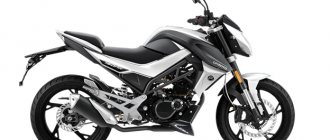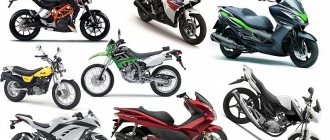Motorcycle equipment
Every vehicle needs maintenance, and a motorcycle is no exception.
Proper care includes not only timely maintenance, but also protection from natural precipitation.
Even a motorcycle that is stored in a garage needs protection; in this case, a cover capable of protecting it from dust and condensation will be sufficient.
As for a vehicle that is stored in a parking lot, it needs protection from dust, dirt, snow, bird droppings, scorching sun rays and prying eyes.
All these harmful substances can ruin the excellent appearance of the “iron horse”, so it is advisable to cover it with a cover.
Types of covers for motorcycles
Today there are several types of motorcycle covers. Both for individual parts of a motorized vehicle - seat, tank, steering wheel, which mainly perform a protective function, and awnings for storing a motorcycle.
They went on sale immediately after the motorcycles appeared on the market, but not everyone pays due attention to this attribute. And in vain, because a new paint coating costs several times more than the most expensive awning cover.
The tents are quite durable. They can protect the vehicle from rain and sun because they are made from high-quality materials that do not allow moisture and ultraviolet rays to pass through. What fabrics are they made from?
Tarpaulin and Oxford are the most commonly used fabrics. They are reliable and perfectly protect the vehicle from the harmful effects of the external environment. All this is due to the fact that on their inside there is a polyvinyl chloride or polyurethane coating.
A special polyurethane impregnation makes the awning waterproof and protects the bike from fungus and mold.
And the polyvinyl chloride coating also has fire-resistant properties, which will help protect it in the event of a fire in a neighboring vehicle.
Such awnings are easy to clean with water or any detergent. As a rule, they have a soft lining inside that protects the motorcycle from scratches during the procedure of removing and putting on the cover. It is also important that the cover is sewn with the least number of seams to avoid leakage of the awning at the joints and has various Velcro, clasps, and zippers for convenient opening and closing.
Don't forget about protecting individual parts of the motorcycle . For example, the seat of an “iron horse” becomes unusable over time if protection in the form of a cover is not used. In addition, such a cover will significantly increase comfort during movement, which is important for every motorcycle owner. Its main function is to protect the seat from various damages, but it also performs an aesthetic function.
There are also special protective covers for the tank on the motorcycle market that help protect the paintwork of the tank from abrasion by the knees. In addition, such cases are very convenient to use, since they may have pockets for storing necessary small items - navigators, maps, etc. However, such protection may not suit the style of everyone, although such a thing would look very good on some cafe racer.
A motorcycle handlebar cover rather serves a decorative function . It can be handmade and sewn from leather.
How to choose the right drag sled for a snowmobile, read our recommendations.
We offer you a review of snowmobile glasses: .
How to make patterns for car seat covers: tips and instructions
Over time, the upholstery of seats in a car interior loses its attractive appearance, gets dirty and wears out. Car covers will help extend the life of the upholstery and even add style to the interior. Stores offer a wide selection of different materials.
Well-chosen car covers add style to the car interior (photo: restavraciya-peretyazhka-mebeli.ru)
The best option is covers made individually to the shape and size of the seats of a particular car. You can make them yourself by choosing the right fabric and patterns for sewing car covers.
How to sew a motorcycle cover
Today on the Internet there are many different videos on sewing a motorcycle cover. Therefore, if you are not ready or do not want to pay a lot of money for a protective cape, you can sew it yourself. To do this, you do not need to have ideal sewing skills, but you just need to remember a few rules:
- The cover will cope with the function of protecting the motor vehicle well if it is made for a specific model. Then it will cover all significant details and will look aesthetically pleasing. Therefore, it is necessary to take the dimensions of the motorcycle yourself, without relying on the data specified in the motorcycle’s registration certificate. After all, you need an awning that will completely cover your vehicle, and this will increase its length significantly. Don’t forget about the additional options for your motorcycle – a case, a backrest, glass, an antenna; they will also significantly increase the size of your future awning.
- When sewing, it is important to remember that the awning should have as few seams as possible, in order to avoid situations with water leakage.
- Also, when making a cover, you need to decide in advance when you will cover the motor vehicle. When it has already cooled down or immediately after working with a hot engine and exhaust system. In the first case, you can sew an awning from any material. If you choose the second option, then the cover should be sewn with heat-resistant linings.
- For easy, quick and convenient operation, the tent cover should be equipped with a zipper, locks, Velcro or elastic bands. Otherwise, during strong winds, it will inflate and rise.
The dynamic and durable Suzuki Bandit 600 motorcycle continues to be at the peak of its glory.
You can find photos of Bobber-style motorcycles in our article.
What to look for when buying a case
First of all, it is necessary to take into account that not every awning is designed for outdoor conditions. Cheaper seasonal products fade quite quickly and are only suitable for use in a garage or covered parking lot. Waterproof, all-season and sealed covers will serve faithfully in any conditions. One example of such awnings is the all-weather Oxford Aquatex canopy, costing from 1,600 to 2,400 rubles, depending on the size of the “bike”.
Speaking of dimensions. Self-respecting manufacturers pay more attention to tailoring their products, and always offer customers a whole line of accessories of different sizes (for scooters, small, medium and large motorcycles). Such capes take into account more design features of “bikes”, so they have better characteristics.
For example, motorcycle covers from the Swiss company IXS, which produces high-quality motorcycle equipment, are made according to patterns in 5 sizes.
| Model | Motorcycle type | Approximate cost, rub |
| SCO | Scooter | 2 600 |
| STD | Station wagon, sport bike, road bike | 3 400 |
| TOU | Tourer, motorcycle with windshield and panniers | 2 900 |
| CHO | Chopper, cruiser | 2 700 |
| VER | Motorcycle with windshield and trunk | 2 200 |
Healthy! The motor cover should not sag, drag on the ground or flutter in the wind.
Typically, protective products are secured on motorcycles using a tightening cord that runs along the lower edge of the cape (some models have additional fasteners). If the product is simply thrown onto the “bike” without any fixation, then it is only suitable for use indoors.
In addition, today manufacturers offer products with opening pockets on the dashboard, as well as with additional ventilation holes.
It is also worth paying attention to the fact that in some countries the police require the use of only those awnings that are equipped with transparent windows, through which officers of the law can easily determine the license plates of the “bike”.
However, given the relatively decent cost of products of this type, many prefer to make them themselves. Of course, the result obtained will be far from ideal; in addition, sewing will require knowledge of how to prepare patterns and at least minimal sewing skills. If you have experience in needlework, then sewing a product like in the video will not be difficult.
Photo gallery
Protective covers for motorcycles are one of the necessary accessories that are needed during the operation of a bike; we invite you to familiarize yourself with its varieties in our photo selection.
Rigidity frame
Materials:
- masking/stationery tape
- epoxy resin
- fiberglass/fiberglass
- fiberglass putty
- construction mesh
- sheet metal (for more advanced skill levels)
Initially, you take masking and stationery tape as tools. The painting shop is needed as a primary base. You use it to cover the workspace on the frame. Paste regular stationery tape on top, which is needed to protect the painter's tape from soaking.
Binders are applied to the created canvas, which form our seat - epoxy resin that impregnates layers of fiberglass or putty with fiberglass. Construction nets are often placed in the foundation to give the form greater strength.
Note that the thinner layers you use, the easier it is to give them the desired rounded shapes. The seat must exactly follow the contours of the frame, since after drying it will be more problematic to change its shape. Your workpiece should not have any cracks or wavy outlines relative to the frame; it must fit snugly and evenly.
And yes, if your seat is held on by bolts, you can reasonably take care of this right away. It is convenient to make bolts or other parts of fastenings part of the frame and glue the bolt heads into resin so that they do not get lost anywhere and already know their rightful place.
Experienced craftsmen or those who know how to work with metal make frames from sheet iron, sometimes even making complex frames using welding.
After the main workpiece has dried, we move on to the next stage of work.
Why doesn't everyone use a motorcycle cover?
In fact, what keeps me from buying a cover is not the cost, but simple laziness. If you think about it, ordinary users associate a motorcycle cover not with its protective properties, but with labor costs. Everyone just wants to park the motorcycle and immediately run about their business, and upon returning, click the key and rush off into the dusty distance. With a motorcycle cover, you first take it out, then unfold it, throw it on the motorcycle, straighten it, check that it doesn’t burn from the hot pipe, fasten it, and only then go about your business. Moreover, upon your return, be so kind as to shake off from the cover everything that has attacked it or has leaked during your absence, roll it up and fold it, and only then start warming up the engine. It's a chore. It requires time, and although not much, it does require work. It is for this seemingly nonsense reason that the pilot bypasses the purchase of a motorcycle cover.
The second reason not to buy a cover is the way to store the motorcycle, they say I have a covered parking lot or a garage, why do I need a cover?
But in vain. Even in a garage or covered parking lot, does a cover protect your treasure or do you think that there is no dust within the four walls?
Filling the base
When your frame blank is ready, the next step is filling it. A good option is polyurethane foam, on which softer fabrics, felt, foam rubber and other porous materials are attached on top.
To create the desired shape, you can take thinner materials and use them in more layers. When creating a “frog” saddle, sometimes it is enough to find old Soviet seats from the “Ural” or “Dnepr” as a blank. And then work wonders only with the case.











